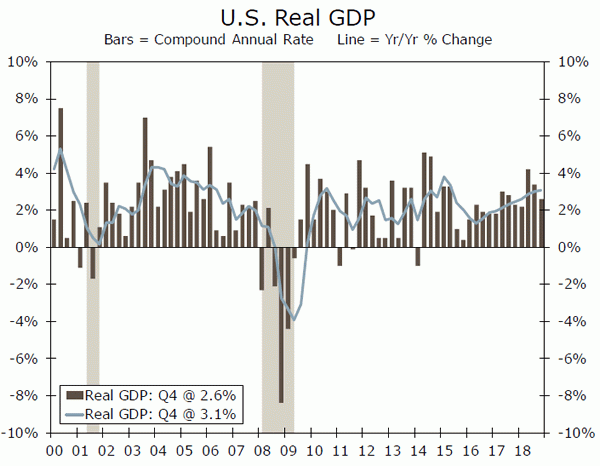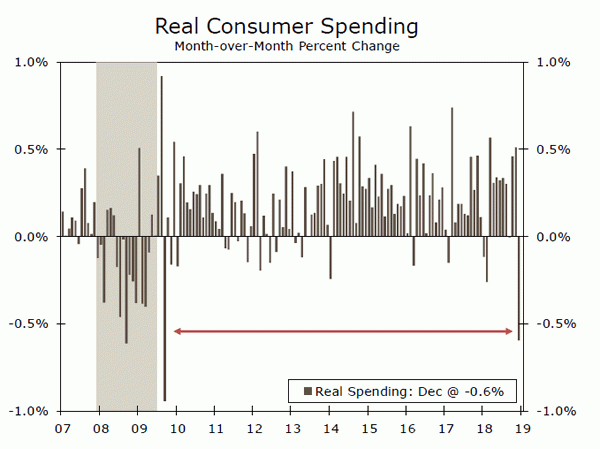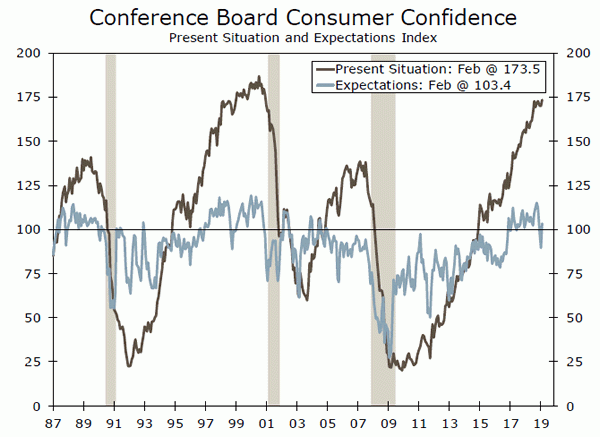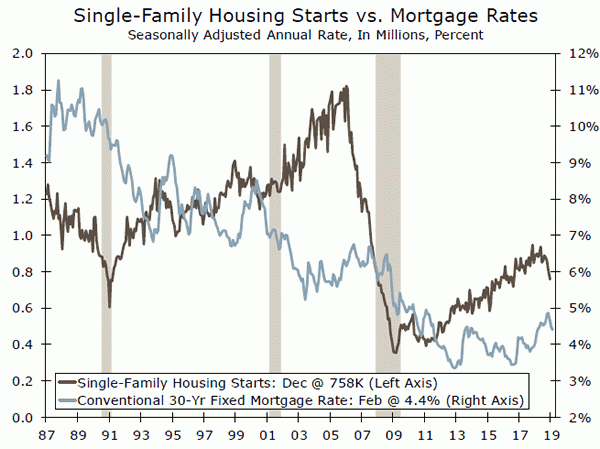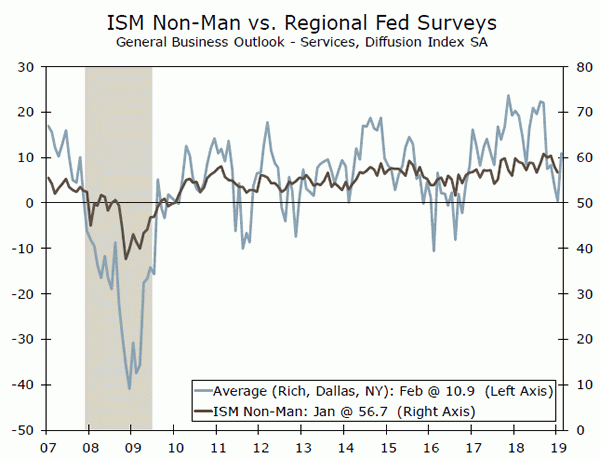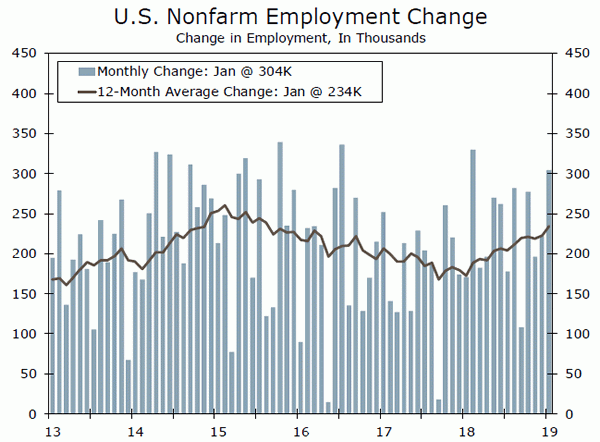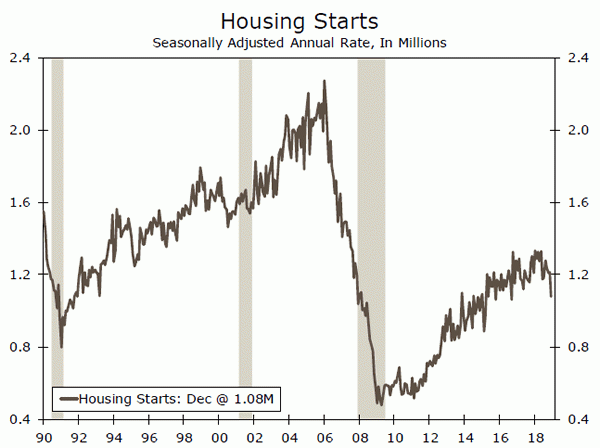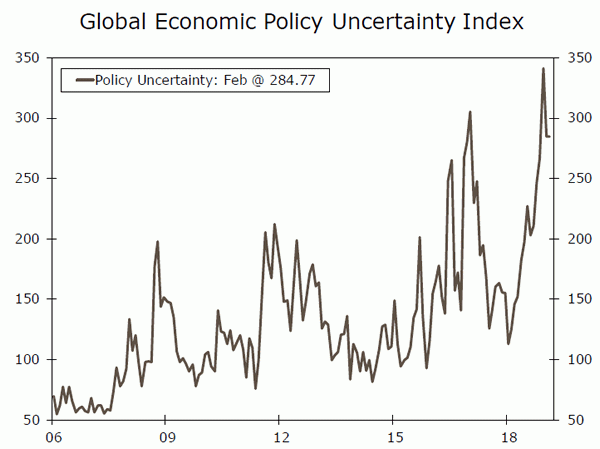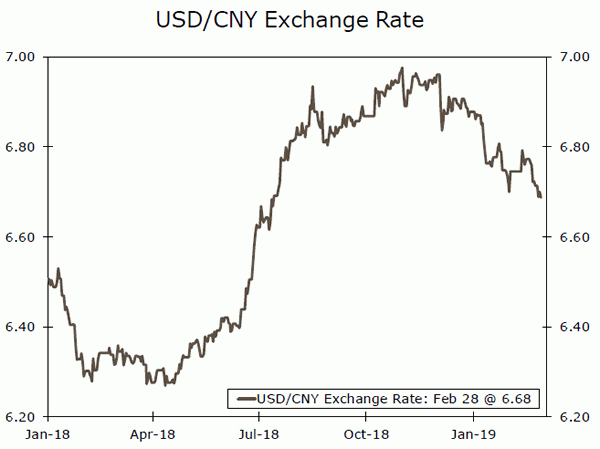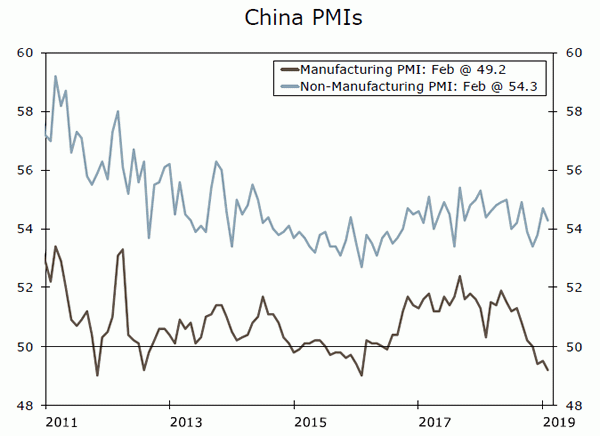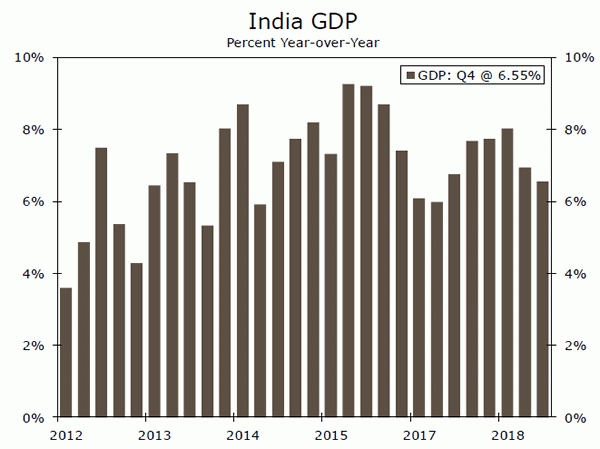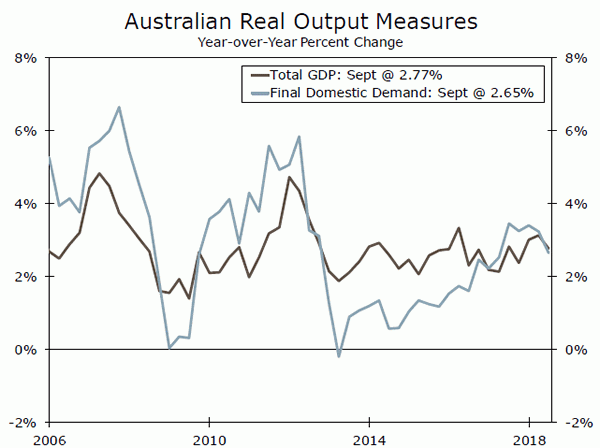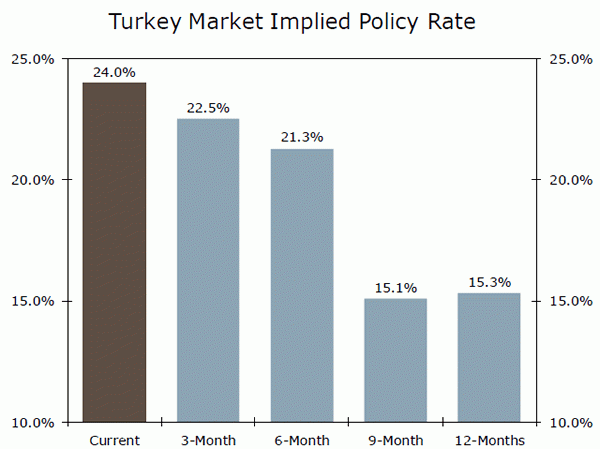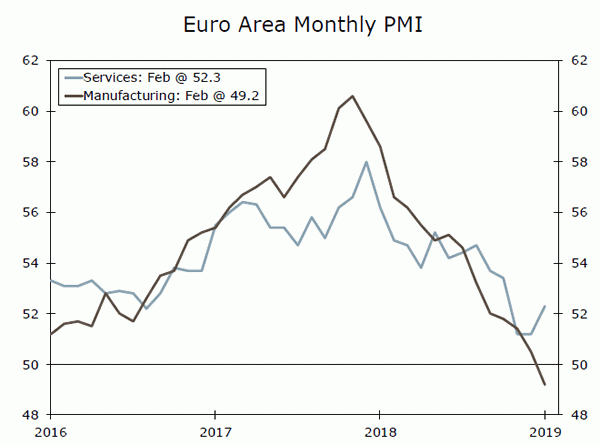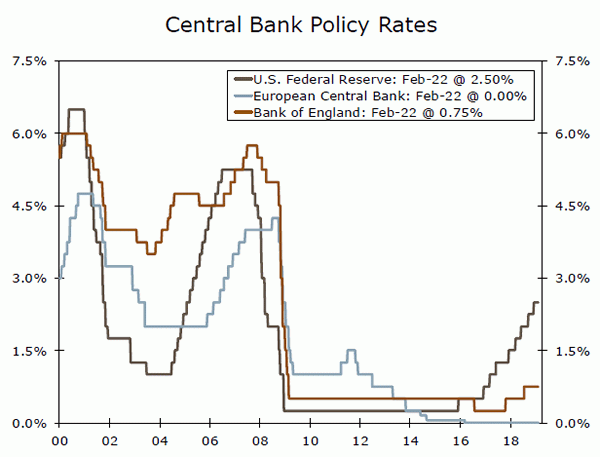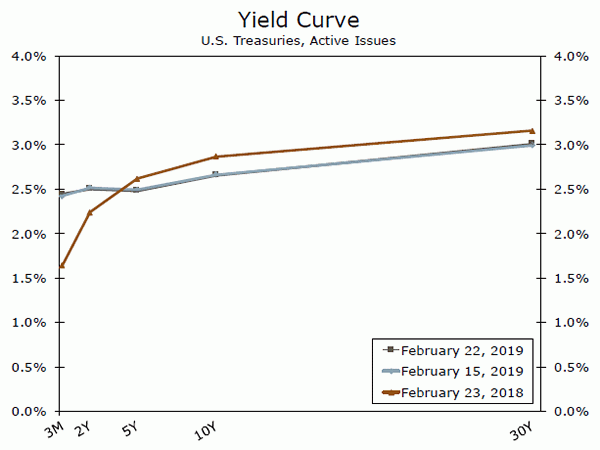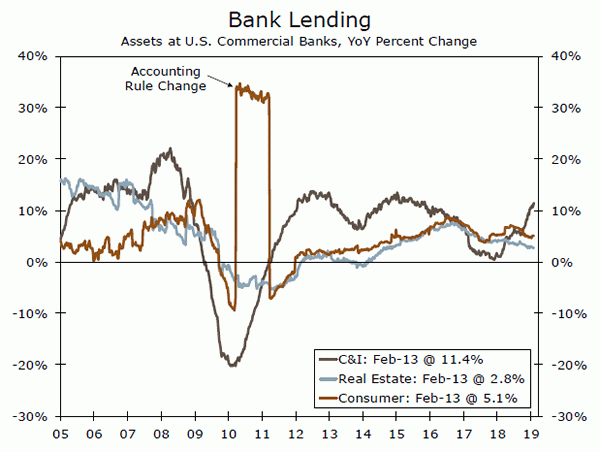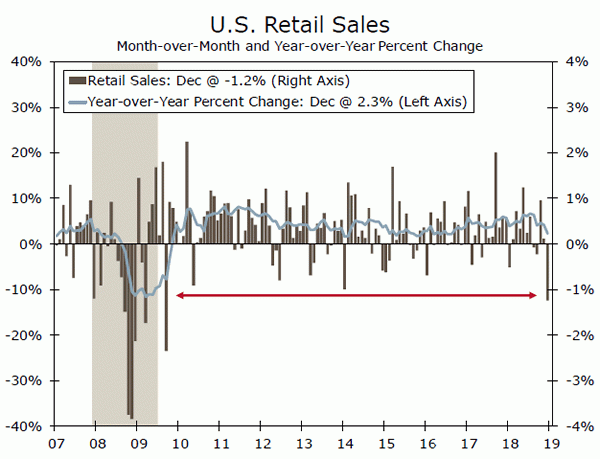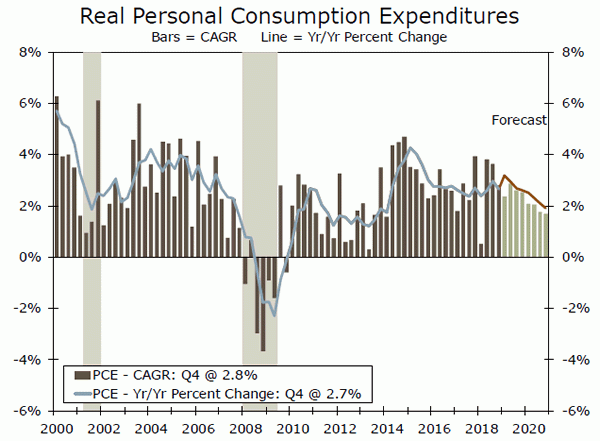U.S. Review
Drawing the Curtain on 2018
- Economic data out the gate this week provided some clarity on how the economy fared through the end of 2018.
- Real GDP in the United States grew at an annualized rate of 2.6% in the fourth quarter. This marked a deceleration from the breakneck pace seen in the prior two quarters, but was above the market expectation of a 2.2% gain.
- Q4 GDP data and housing starts and personal income and spending data now available through December, confirmed our expectation of a slowdown in growth to end 2018.
Drawing the Curtain on 2018
Economic data out the gate this week provided some clarity on how the economy fared through the remainder of 2018. The partial government shutdown, which began in December and lasted well into January, had continued to delay important data releases, clouding analysts’ assessments of the economy’s performance. Data on Q4-GDP, and housing starts and personal income and spending data now available through December, confirmed our expectation of a slowdown in growth to end 2018.
The U.S. Commerce Department released data on Thursday which showed that real GDP grew at an annualized rate of 2.6% in the fourth quarter. While this pace of growth still represents a step down from the strong growth rates experienced earlier last year, at 2.6% growth was above the market expectation of 2.2%.
Real personal consumption expenditures (PCE), grew only 2.8% in the fourth quarter, leading much of the deceleration in GDP growth. The weakness can be traced to the weak spending environment in December, with both personal spending and retail sales experiencing their largest declines since the recession year of 2009. Real PCE was in part boosted earlier last year by personal tax cuts, but these real income-boosting effects will likely fade this year. Personal income rose 1.0% in December, but fell 0.1% in January. Income growth should regain some strength this year, due to the robust labor market.
Consumer confidence data for February suggested consumers have regained some optimism. The present-situation component of the index improved to a cycle-high of 173.5, while the expectations component jumped 14 points. Expectations of job prospects and improvements in income have propelled the outlook, but fewer purchasing plans of autos, homes and major appliances weighed on overall optimism. Taking this anecdotal indication with recent hard data on durable goods orders suggests that growth in capital spending will likely be anemic in the first half of 2019.
After a slow pace of growth in the third quarter, business fixed investment (BFI) spending rebounded at a rate of 6.4% in the fourth quarter. But, the construction components of BFI remained weak. Non-residential construction fell 4.2%, while the residential side declined for the fourth consecutive quarter. A separate press release from the Commerce Department revealed that housing starts plunged 11.2% in December. Mortgage rates were up to a near 5% last year, which threatened to worsen the affordability crisis that has been dragging home sales and new home construction lower since March of last year. Rising home prices had only exacerbated weakness in residential construction last year. But, with mortgage rates now lower and building permits having risen in January, there may be some upside pressure to housing starts in 2019.
Despite the slowdown in the fourth quarter, the stronger-thanexpected GDP outturn should alleviate some concern that the economy is in serious trouble. As we look further ahead to 2019, our current forecast looks for a further deceleration in the first quarter but for a modest rebound starting in the second quarter.
U.S. Outlook
ISM Non-Manufacturing • Tuesday
The ISM non-manufacturing index fell 1.3 points in January. At 56.7, the index remains consistent with the economy expanding at a decent rate, but the pullback added to the evidence that the U.S. economy has lost some momentum since the second half of 2018. Part of the drop in January may have been attributable to the government shutdown, as a number of survey respondents noted its negative effect in their comments. With the shutdown over, we expect to see a modest bounce-back in the February ISM nonmanufacturing index, consistent with the service-sector PMIs from the Federal Reserve system rebounding.
Another near-60 reading would suggest that the U.S. economy is handling recent “crosscurrents” without much issue and therefore raise the prospect of the FOMC increasing the fed funds rate again this year. A downside miss, however, would support the FOMC remaining in its current holding pattern on rates.
Previous: 56.7 Wells Fargo: 57.2 Consensus: 57.3
Employment • Friday
Hiring got off to a robust start to the year with employers adding 304,000 new jobs in January. We suspect job growth moderated in February, however. Jobless claims have drifted up over the past month, PMI employment readings have softened since late last year and hiring of temporary help has slowed. In addition, the partial government shutdown that stretched nearly all of January and was only tentatively resolved through the first half of February likely delayed some federal sector and private contractor hiring. With furloughed workers back on the job in February, however, the jobless rate should resume its downward trend and fall to 3.9%.
Another blowout report would raise questions about how long the FOMC may remain “patient” before lifting rates further this year. A surprisingly soft number, however, is unlikely to sway the Fed’s nearterm policy stance given that a broad array of data still point to a strong jobs market overall.
Previous: 304,000 Wells Fargo: 195,000 Consensus: 188,000
Housing Starts • Friday
Housing starts tumbled at the end of 2018, dropping 11.2%. That was the third decline in four months, as builder confidence late in the year was sapped by higher mortgage rates. We expect to see a modest rebound in housing starts for January, and further improvements in the following months. Since nearly reaching 5.00% in November, mortgage rates have fallen roughly 60 bps, fueling some improvement in homebuilder sentiment. At the same time, multifamily permits have been running ahead of starts.
Housing data this time of year must be interpreted with caution given that low levels of activity in the winter can lead to exaggerated readings after seasonal adjustment. With that caveat in mind, another surprisingly soft print in January would suggest that the housing sector remains in a somewhat perilous position, while a stronger-than-expected rebound would suggest that the Fed’s softer stance is already feeding through to the economy.
Previous: 1.08M Wells Fargo: 1.20M Consensus: 1.17M
Global Review
Global Uncertainty Remains Elevated For the Time Being
- Geopolitical developments dominated headlines for the majority of the week, highlighted by President Trump’s second meeting with Kim Jung Un, a delay in additional tariffs on Chinese exports, as well as military engagement between India and Pakistan.
- While each of these situations presents its own risks, in aggregate they have the ability to result in heightened levels of global uncertainty. While we do not expect any major escalations in these geopolitical events at this time, it is worth noting these potential event risks still exist and can potentially have lasting impacts on market sentiment.
Geopolitics Remain in Focus
Many of the headlines we witnessed this week were dominated by geopolitical developments around the world, highlighted by president Trump’s second meeting with North Korean leader Kim Jung Un as well as President Trump’s decision to delay additional tariffs on Chinese exports to the United States. As expected, the second meeting between President Trump and Kim Jung Un did not yield too many tangible results towards the de-nuclearization of North Korea. In fact, media reports suggest the meeting ended rather abruptly, with neither side willing to make sufficient concessions at this time. While tensions in 2017-2018 have receded, the North Korean leaders’ unwillingness to completely destroy missile test sites and abandon the country’s nuclear capabilities, along with President Trump’s cautious approach towards removing economic sanctions on North Korea, may add to additional uncertainty going forward.
In contrast, some progress has been made over the past few months in regard to the United States’ ongoing trade negotiations with China. While a long-term deal has yet to be made, President Trump’s decision to delay additional tariffs on Chinese exports was greeted with optimism, suggesting a deal may be made in the near future. As of now, China has agreed to purchase additional U.S. goods, particularly as it relates to agricultural products; however, differences still exist over issues of technology transfers and intellectual property theft. These differences culminated in U.S Trade Representative Robert Lighthizer commenting that the two countries are still far apart on making a trade deal. However, markets seem to be relatively optimistic for the prospects of a deal, evidenced by the recent strength of the Chinese renminbi, arguably the most sensitive asset to tariffs and trade discussions.
The persistent trade tensions also appear to be having a more notable impact on China’s economy as well. While a deceleration in Chinese economic activity has been underway for some time, the imposition of tariffs has likely exacerbated a slowdown in China’s growth. Recent data continue to suggest a further slowdown in the Chinese economy, with February’s manufacturing PMIs falling further, while the non-manufacturing PMIs slowed as well.
Outside of geopolitical developments directly involving the U.S., India and Pakistan engaged in military activity with each other this week. The ongoing skirmish originated from a Pakistani terrorist attack in India, which prompted retaliation from India’s military. At the current juncture, Pakistan is holding an Indian pilot captive, although recent comments from the Prime Minister of Pakistan suggest his willingness to release him in an effort to de-escalate the situation. Should this escalate any further, it could result in a slowdown of foreign capital flowing into India, which may have an impact on the country’s growth outlook. GDP growth in India has recently underperformed expectations, with Q4 growth of 6.6% YoY missing estimates and indicating a further slowdown in the economy. These developments could also have implications for India’s upcoming general election, where current Prime Minister Narendra Modi has already lost some of his support.
Global Outlook
Australia GDP • Tuesday
Australian economic data have been quite weak over the past few months, highlighted by a notable GDP slowdown in Q3-2018. That sluggishness may have carried over into Q4 as well, with leading indicators suggesting another subdued quarter of GDP growth. Domestic imbalances have likely contributed to the weak data; however, we expect China’s slowdown has played a sizeable role in Australia’s softening economy as well. Economic ties between the two Asia-Pacific countries are significant, with about 35% of Australia’s total exports going to China. As China’s economy continued to show signs of slowing down towards the end of last year, we expect this to impact Australia’s Q4-GDP release next week. The slowdown in Australia’s economy has caught the attention of the Reserve Bank of Australia (RBA) as well. The RBA recently shifted to a more neutral monetary policy stance, moving away from a slightly hawkish bias, citing concerns over the country’s outlook.
Previous: 0.3% Consensus: 0.5% (Quarter-over-Quarter)
Central Bank of Turkey • Wednesday
The central bank of Turkey will announce its decision on its main policy rate next week, with consensus forecasts suggesting a hold is likely. However, we believe the likelihood for a policy rate cut at the March 6 meeting is higher than consensus forecasts currently anticipate. With CPI inflation softening more than expected, and a lira that has been relatively stable since its significant depreciation in 2018, this could provide the central bank with scope to prematurely cut policy rates. Concerns regarding the independence of the central bank still exist as well, and with local elections coming up at the end of March, the Turkish administration may choose to put pressure on the central bank to prioritize growth and reduce policy rates. Markets may be taking that view as well, as they are currently pricing in 150 bps of rate cuts over the next three months and also imply about 900 bps of cumulative rate cuts over the next 12 months may be coming as well.
Previous: 24.00% Consensus: 24.00%
European Central Bank • Thursday
With economic data indicating a further deceleration in the broader European economy, markets will likely be paying close attention to next week’s ECB meeting. While a policy rate move is not expected, market participants are likely to be focused on ECB President Mario Draghi’s comments as well as any revised growth and inflation targets. While we expect some additional downward revisions to the ECB’s growth and inflation forecasts, we will also be looking for any shift in commentary surrounding the balance of risks to the European economy. A further acknowledgement of downside risks could potentially be accompanied by an additional round of stimulus measures, particularly in the form of Targeted Long-Term Refinancing Operations (TLTROs). In addition, we believe markets will also look for hints that the ECB may delay policy rate hikes longer than expected and continue to keep accommodative monetary policy in place through the end of the year.
Previous: -0.40% Wells Fargo: -0.40% Consensus: -0.40%
Point of View
Interest Rate Watch
Powell Reiterates “Patience”
Federal Reserve Chairman Powell presented the Fed’s Semi-Annual Monetary Policy Report to two congressional committees this week. In general, Powell presented a fairly upbeat assessment of the U.S. economy. He said that the Federal Open Market Committee (FOMC) views “current economic conditions as healthy and the economic outlook as favorable,” and he characterized the job market as “strong.”
That said, Powell also acknowledged “some crosscurrents and conflicting signals.” Powell mentioned the volatility that hit financial markets late last year and signs of slower growth in some major foreign economies. Both factors, if prolonged, could cause the U.S. economy to decelerate even more than it already has.
During the Q&A session, Powell continued to stress that the FOMC could be “patient” regarding its next policy steps. Although the economy has decelerated somewhat, the overall pace of economic activity appears to remain solid. Furthermore, consumer price inflation is currently running more or less at the Fed’s target of 2%. Thus, there is no need for the FOMC to rush into further rate hikes. Nor does growth appear weak enough that the FOMC needs to start easing policy. Fed policymakers have the luxury of being able to see what incoming economic data over the next few months portend for the economic outlook.
In that regard, we continue to forecast that the FOMC will judge it necessary to tap on the brakes again with another 25 bps rate hike later this year. For starters, overall financial market conditions are less tight today than they were at the end of last year. In addition, the drag from the housing market on real GDP growth should lessen due to the recent decline in mortgage rates. Investment spending should also strengthen somewhat if, as we expect, uncertainties related to trade policy begin to dissipate. Although we look for real GDP growth to slow in Q1 from the 2.6% rate that it registered in Q4-2018, we forecast that growth will strengthen again in Q2. If, as we forecast, the labor market tightens further in coming months, then the FOMC should conclude that another rate hike is needed.
Credit Market Insights
Shock and Spend
When consumers receive a sudden boost to their income, they are most likely to save or pay down debt. And when their income unexpectedly drops, they are most likely to reduce spending, according to the New York Fed’s survey of consumers’ marginal propensity to spend. Upon receiving an unexpected windfall, consumers report that they would spend only 17%, while saving or paying down debt with the remainder. More than a year after the passage of the Tax Cuts and Jobs Act—which reduced taxes on average by $1,600 per household, according to the Tax Policy Center—we can attempt to look at how consumers behaved. The household sector has certainly deleveraged over the past decade, with the debt-todisposable income ratio currently sitting at the lowest level since 2001, and down almost a third since its peak in 2007. Domestic demand for safe assets has also been quite strong. At the same time, personal consumption grew quite strongly over 2018, fueled by the aforementioned fiscal stimulus as well as a robust labor market that is finally generating some higher wage growth.
The survey suggests an asymmetric response to income shocks—when income unexpectedly drops, 75% is covered by reduced spending. The possibility of smaller tax refunds to start this year provides another interesting case study of how consumers respond to external shocks to their income. Still, we do not expect lower refunds to significantly reduce consumer spending this year—read more here.
Topic of the Week
December Chill in Consumer Spending
The year 2018 ended with a thud. Stock markets nosedived into the final days of the year to mark one of the biggest year-end selloffs in memory. Congress was also unable to reach agreement on an appropriations bill and was thus forced to shut down the government on December 22.
It is fair to say that some consumers were simply not in the holiday spirit. After peaking in October, measures of consumer confidence slipped for three straight months and some retailers reported lighter activity in the final month of the year.
Another cost of the government shutdown (beyond adding to consumer anxieties) was that it delayed the release of the December retail sales report. When those numbers finally became available, they raised more than a few eyebrows. Control group retail sales, which serve as a proxy for consumer spending as it is reported in the GDP accounts, plunged 1.7%, the biggest sequential decline in almost 20 years and larger than any single month drop during the 2007-2009 recession. Are things really that bad?
The quick answer is no. That was more or less confirmed this week with the GDP report which revealed a respectable 2.8% growth rate for real PCE in the fourth quarter. But on Friday, the picture came a bit more into focus with the release of the combined December and January personal income and spending report.
The shadow of the shutdown still hangs over us and the report offered only personal income figures for January and the usual full report for December. Yes, spending slipped in December, but it was revised higher for November. A scant decline in income for January may reflect payback after an upwardly revised surge in December. Consumer confidence is rebounding, as evident in the University of Michigan’s survey of consumer sentiment which improved in February. Consumers face some headwinds and we see scope for a moderation in growth, but this is not the beginning of a steep retrenchment in our view.




